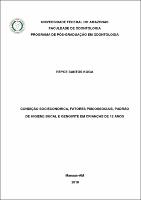| ???jsp.display-item.social.title??? |


|
Please use this identifier to cite or link to this item:
https://tede.ufam.edu.br/handle/tede/6288Full metadata record
| DC Field | Value | Language |
|---|---|---|
| dc.creator | Koga, Reyce Santos | - |
| dc.creator.Lattes | http://lattes.cnpq.br/1265251335857551 | por |
| dc.contributor.advisor1 | Pimentel, Adriana Corrêa de Queiroz | - |
| dc.contributor.advisor1Lattes | http://lattes.cnpq.br/7995668886167934 | por |
| dc.contributor.advisor-co1 | Herkreth, Ana Paula Corrêa de Queiroz | - |
| dc.date.issued | 2018-02-21 | - |
| dc.identifier.citation | KOGA, Reyce Santos. Condição socieconômica, fatores psicossociais, padrão de higiene bucal e gengivite em crianças de 12 anos. 2018. 88 f. Dissertação (Mestrado em Odontologia) - Universidade Federal do Amazonas, Manaus, 2018. | por |
| dc.identifier.uri | https://tede.ufam.edu.br/handle/tede/6288 | - |
| dc.description.resumo | A gengivite é uma condição bastante comum em crianças e adolescentes, O principal fator de risco para as doenças periodontais é o acúmulo de biofilme no nível e abaixo da margem gengival. Contudo, outros fatores socioeconômicos, psicossociais e comportamentais podem influenciar fortemente as condições clínicas bucais. O objetivo deste estudo foi avaliar o papel mediador da autoestima, crenças em saúde bucal e frequência de escovação dentária na relação entre as características socioeconômicas e prevalência de sangramento gengival e efetividade de higiene bucal em escolares de 12 anos, guiado por um modelo teórico-conceitual. A população do estudo consistiu de 406 alunos da rede pública municipal da Zona Leste da cidade de Manaus-AM. Os participantes responderam a um questionário com informações relacionadas a condição socioeconômica, autoestima, crenças em saúde bucal e frequência de escovação dentária. Os exames clínicos foram realizados com sonda periodontal do tipo OMS e espelho clínico para avaliação de sangramento gengival e presença de cálculo dentário. A análise estatística foi conduzida em 3 fases: análise descritiva dos dados, análise fatorial confirmatória (AFC) do modelo de mensuração e modelo de equação estrutural (MEE). A prevalência de sangramento gengival nas crianças foi de 77,6% e de cálculo dentário, 57,4%. A maioria das crianças (89,2%) relatou que escova os dentes três ou mais vezes ao dia. Pior condição socioeconômica relacionou-se diretamente a uma menor frequência de escovação dentária e maior sangramento gengival. Crenças em saúde bucal mais positivas e autoestima mais elevada foram diretamente relacionadas com uma maior frequência de escovação dentária e indiretamente associadas com menor sangramento gengival, via frequência de escovação dentária e efetividade da higiene bucal. Os escolares com menor efetividade da higiene bucal apresentaram maior sangramento gengival. Não houve mediação dos fatores psicossociais na relação entre condição socioeconômica e sangramento gengival. No entanto, houve mediação da frequência de escovação dentária na relação indireta de ambos os fatores psicossocias (autoestima e crenças em saúde bucal) e o sangramento gengival. | por |
| dc.description.abstract | Gingivitis is a fairly common condition in children and adolescents. The main risk factor for periodontal disease is the accumulation of biofilm at the level and below the gingival margin. However, other socioeconomic, psychosocial and behavioral factors may strongly influence oral clinical conditions. The objective of this study was to evaluate the mediating role of self-esteem, oral health beliefs and frequency of dental brushing in the relationship between socioeconomic characteristics and prevalence of gingival bleeding and oral hygiene effectiveness in 12-year-old students, guided by a theoretical-conceptual model. The study population consisted of 406 students from the municipal public network of the East Zone of the city of Manaus-AM. Participants answered a questionnaire with information related to socioeconomic status, self-esteem, oral health beliefs and frequency of toothbrushing. The clinical exams were performed with a WHO periodontal probe and clinical mirror to evaluate gingival bleeding and presence of dental calculus. The statistical analysis was conducted in three phases: descriptive data analysis, confirmatory factorial analysis (CFA) of the measurement model and structural equation model (SEM). The prevalence of gingival bleeding in children was 77.6% and dental calculus 57.4%. Most children (89.2%) reported that they brush their teeth three or more times a day. Worse socioeconomic condition was directly related to a lower frequency of dental brushing and greater gingival bleeding. More positive oral health beliefs and higher self-esteem were directly related to a higher frequency of dental brushing and indirectly associated with less gingival bleeding, tooth brushing frequency and oral hygiene effectiveness. The students with lower oral hygiene effectiveness showed greater gingival bleeding. There was no mediation of psychosocial factors in the relationship between socioeconomic status and gingival bleeding. However, dental brushing frequency was mediated in the indirect relation of both psychosocial factors (self-esteem and beliefs in oral health) and gingival bleeding. | eng |
| dc.format | application/pdf | * |
| dc.thumbnail.url | https://tede.ufam.edu.br//retrieve/20949/Disserta%c3%a7%c3%a3o_Reyce%20S.%20Koga.pdf.jpg | * |
| dc.language | por | por |
| dc.publisher | Universidade Federal do Amazonas | por |
| dc.publisher.department | Faculdade de Odontologia | por |
| dc.publisher.country | Brasil | por |
| dc.publisher.initials | UFAM | por |
| dc.publisher.program | Programa de Pós-graduação em Odontologia | por |
| dc.rights | Acesso Aberto | por |
| dc.rights.uri | http://creativecommons.org/licenses/by-nc-nd/4.0/ | - |
| dc.subject | Gengivite | por |
| dc.subject | Saúde bucal | por |
| dc.subject | Autoestima | por |
| dc.subject | Higiene bucal | por |
| dc.subject | Sangramento gengival | por |
| dc.subject.cnpq | CIENCIAS DA SAUDE: ODONTOLOGIA: ODONTOPEDIATRIA | por |
| dc.title | Condição socieconômica, fatores psicossociais, padrão de higiene bucal e gengivite em crianças de 12 anos | por |
| dc.type | Dissertação | por |
| Appears in Collections: | Mestrado em Odontologia | |
Files in This Item:
| File | Description | Size | Format | |
|---|---|---|---|---|
| Dissertação_Reyce S. Koga.pdf | 1.09 MB | Adobe PDF |  Download/Open Preview |
This item is licensed under a Creative Commons License





